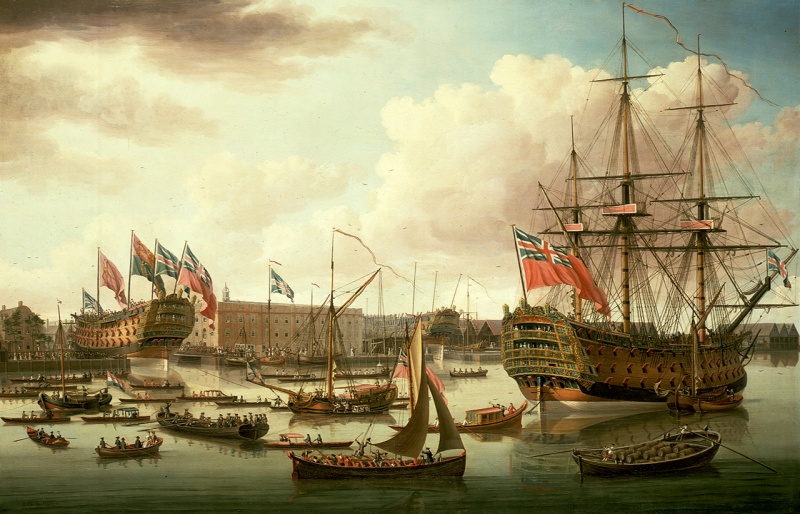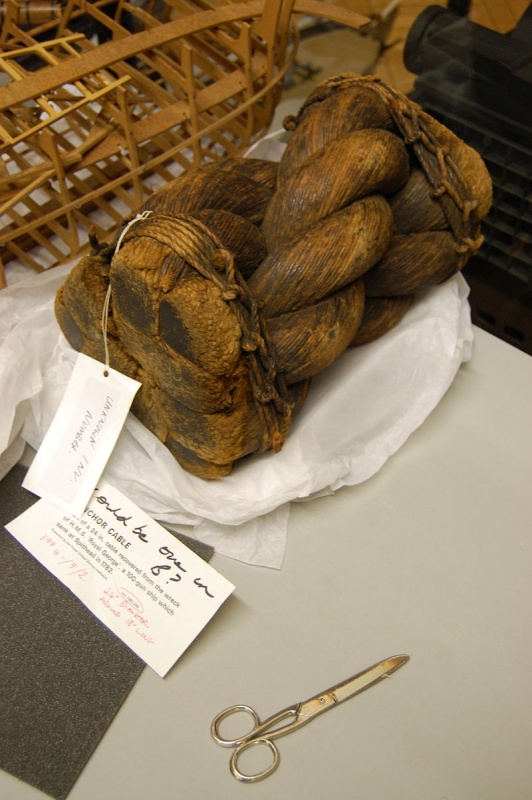Having produced a series of short profiles on the ships at the Battle of the Basque Roads, I wondered if it would be of interest if I did the same for other ships of the era?
So here goes. I will start with the three deckers of the British Navy.
FIRST RATERS.
HMS Royal George (1756)

HMS Royal George,, shown fictitiously
at the launch of HMS Cambridge in 1755
by John Cleveley the Elder (1757)
HMS Royal George was a 100-gun first-rate ship of the line of the Royal Navy, built at Woolwich Dockyard and launched on 18 February 1756. The largest warship in the world at the time of launching,
She saw service during the Seven Years' War including being Admiral Sir Edward Hawke's flagship at the Battle of Quiberon Bay and later taking part in the Battle of Cape St Vincent. She sank undergoing routine maintenance work whilst anchored off Portsmouth on 29 August 1782 with the loss of more than 800 lives, one of the most serious maritime losses to occur in British waters.
History Great Britain Name: HMS Royal George Ordered: 29 August 1746 Builder: Woolwich Dockyard Laid down: 8 January 1747 Launched: 18 February 1756 Commissioned: October 1755 (before launch) Fate: Foundered, 29 August 1782, at Spithead Notes:
- Participated in:
- Battle of Quiberon Bay
- Battle of Cape St Vincent
General characteristics Class and type: 1745 Establishment 100-gun first-rate ship of the line Tons burthen: 2047 bm Length:
- 178 ft (54.3 m) (gundeck)
- 143 ft 5.5 in (43.7 m) (keel)
Beam: 51 ft 9.5 in (15.8 m) Depth of hold: 21 ft 6 in (6.6 m) Propulsion: Sails Sail plan: Full rigged ship Armament:
- 100 guns:
- Gundeck: 28 × 42 pdrs
- Middle gundeck: 28 × 24 pdrs
- Upper gundeck: 28 × 12 pdrs
- Quarterdeck: 12 × 6 pdrs
- Forecastle: 4 × 6 pdrs
Several attempts were made to raise the vessel, both for salvage and because she was a major hazard to navigation. In 1782, Charles Spalding recovered six iron 12-pounder guns and nine brass 12-pounders using a diving bell of his design. From 1834–1836, Charles and John Deane recovered more guns using the surface-air supplied diving helmet which they had invented, and in 1839 Major-General Charles Pasley, at the time a colonel of the Royal Engineers, commenced operations to break up the wreck using barrels of gunpowder.
Pasley's team recovered more guns and other items between 1839 and 1842. In 1840, the remaining structure of the wreck was destroyed by the Royal Engineers in an explosion that shattered windows as far away as Portsmouth and Gosport.
Service.
Ordered on 29 August 1746, she was laid down at Woolwich Dockyard in 1746 as Royal Anne, and built to the draught specified by the 1745 Establishment. She was renamed Royal George during building and launched on 18 February 1756. At the time of her launch in 1756, she was the largest warship in the world at more than 2,000 tons, and is considered the "eighteenth-century equivalent of a weapon of mass destruction". She served in the Seven Years' War, commissioning under her first commander, Captain Richard Dorrill in October 1755, and after being completed, joined the Western Squadron or Channel Fleet under Admiral Sir Edward Hawke in May 1756.
Dorrill was succeeded by Captain John Campbell in July 1756, who was in turn succeeded by Captain Matthew Buckle in early 1757. Royal George was the flagship of Vice-Admiral Edward Boscawen at this time, and flew his flag in the Raid on Rochefort in September that year.[4] Captain Piercy Brett took command in 1758, during which time Royal George became the flagship of Admiral Lord George Anson. Brett was succeeded by Captain Alexander Hood in November 1758, though Royal George's former captain, Richard Dorrill, was back in command the following year, until being invalided out of the ship in June. Dorrill's replacement was another former captain, John Campbell, who commanded her in the blockade of the French fleet at Brest. She became Sir Edward Hawke's flagship in early November of that year, when his previous flagship, Ramillies, went into dock for repairs. Hawke commanded the fleet from Royal George at the Battle of Quiberon Bay on 20 November 1759, where she sank the French ship Superbe.
Royal George was commanded by Captain William Bennett from March 1760, and she was present at the fleet review at Spithead in July that year.[John Campbell returned to command his old ship in August 1760, though Bennett was captain again by December. Royal George joined Admiral Charles Hardy’s fleet in the Autumn of 1762, and was then paid off on 18 December that year. She was laid up at the conclusion of the Seven Years' War, undergoing a large repair at Plymouth between 1765 and 1768. The outbreak of the American War of Independence generated a need for more ships and Royal George was fitted at Portsmouth for service in the Channel between May 1778 and April 1779.
She recommissioned under her first new commander, Captain Thomas Hallum, in July 1778, with command passing to Captain John Colpoys in November that year. Royal George was at this time the flagship of Vice-Admiral Sir Robert Harland, with the Western Squadron.[4] Harland struck his flag, and in his place Vice-Admiral George Darby briefly raised his in June 1779, though from August 1779 until December 1781 she was the flagship of Rear-Admiral Sir John Lockhart Ross. Meanwhile, Captain Colpoys was replaced by Captain John Bourmaster in December 1779, and she joined Admiral Sir George Rodney's fleet in their mission to relieve Gibraltar. Under Bourmaster, and flying Ross's flag, Royal George took part in the attack on the Caracas convoy on 8 January 1780, and the Battle of Cape St. Vincent on 16 January 1780, before going on to successfully relieve Gibraltar three days later.
Royal George returned to Britain with the rest of the fleet, and had her hull coppered in April 1780. She returned to service that summer, serving with the Channel Fleet under Admiral Francis Geary, and then George Darby from the Autumn.[4] Both captain and admiral changed in late 1781, Bourmaster being replaced by Captain Henry Cromwell, and Ross striking his flag for Royal George to become the flagship of Rear-Admiral Richard Kempenfelt. She served as part of Samuel Barrington's squadron from April 1782, with Cromwell replaced by Captain Martin Waghorn in May. Royal George then joined the fleet under Richard Howe.
Loss.
A contemporary illustration of Royal George resting at the bottom of the Solent with her masts sticking up from the surface
1783 medallion commemorating the sinking of Royal George
[IMG]file:///C:\Users\Admin\AppData\Local\Temp\msohtmlclip1\01\clip_image004.jpg[/IMG]
Loss of the Royal George (painting by John Christian Schetky)
Memorial at Ryde, Isle of Wight, commemorating the loss

A section of the ship's 24-inch anchor cable, recovered from the wreck and now in the Science Museum store at Blythe House
On 28 August 1782 Royal George was preparing to sail with Admiral Howe's fleet to relieve Gibraltar. The ships were anchored at Spithead to take on supplies. Most of her complement were aboard ship, as were a large number of workmen to speed the repairs. There were also an estimated 200–300 relatives visiting the officers and men, 100–200 "ladies from the Point [at Portsmouth], who, though seeking neither husbands or fathers, yet visit our newly arrived ships of war", and a number of merchants and traders come to sell their wares to the seamen.
The reason most of her complement were aboard was because of fear of desertion: all shore leave had been canceled. Accordingly, every crew member then assigned to the vessel was aboard it when it sank, except for a detachment of sixty marines sent ashore that morning. The exact number of the total crew on board is unknown, but is estimated to be around 1,200.
At seven o'clock on the morning of 29 August work on the hull was carried out and Royal George was heeled over by rolling the ship's starboard guns into the centreline of the ship. This caused the ship to tilt over in the water to port. Further, the loading of a large number of casks of rum on the now-low port side created additional and, it turned out, unstable weight. The ship was heeled over too far, passing her centre of gravity. Realising that the ship was settling in the water, the ship's carpenter informed the lieutenant of the watch, Monin Hollingbery, and asked him to beat the drum to signal to the men to right the ship. The officer refused. As the situation worsened, the carpenter implored the officer a second time. A second time he was refused. The carpenter then took his concern directly to the ship's captain, who agreed with him and gave the order to move the guns back into position. By this time, however, the ship had already taken on too much water through its port-side gun ports, and the drum was never sounded. The ship tilted heavily to port, causing a sudden inrush of water and a burst of air out the starboard side. The barge along the port side which had been unloading the rum was caught in the masts as the ship turned, briefly delaying the sinking, but losing most of her crew. Royal George quickly filled up with water and sank, taking with her around 900 people, including up to 300 women and 60 children who were visiting the ship in harbour. 255 people were saved, including eleven women and one child. Some escaped by running up the rigging, while others were picked up by boats from other vessels. Kempenfelt was writing in his cabin when the ship sank; the cabin doors had jammed because of the ship's heeling and he perished. Waghorn was injured and thrown into the water, but he was rescued. The carpenter survived the sinking, but died less than a day later, never having regained consciousness. Hollingbery also survived.
Many of the victims were washed ashore at Ryde, Isle of Wight where they were buried in a mass grave that stretched along the beach. This land was reclaimed in the development of a Victorian esplanade and is now occupied by the streets and properties of Ryde Esplanade and The Strand. In April 2009, Isle of Wight Council placed a new memorial plaque in the newly restored Ashley Gardens on Ryde Esplanade in memory of Royal George. It is a copy of the original plaque unveiled in 1965 by Earl Mountbatten of Burma, which was moved in 2006 to the Royal George Memorial Garden, also on the Esplanade.
A court-martial failed to correctly attribute blame for the tragedy and acquitted the officers and crew (many of whom had perished), blaming the accident on the "general state of decay of her timbers" and suggesting that the most likely cause of the sinking was that part of the frame of the ship gave way under the stress of the heel. The officer of the watch at the time of the sinking was, in fact, most responsible. Naval historian Nicholas Tracy stated that this officer had allowed water to accumulate on the gundeck. The resulting free surface effect eventually compromised the ship's stability. Tracy concluded that an "alert officer of the watch would have prevented the tragedy ..."
A fund was established by Lloyd's Coffee House to help the widows and children of the sailors lost in the sinking, which was the start of what eventually became the Lloyd's Patriotic Fund. The accident was commemorated in verse by the poet William Cowper:
Toll for the brave
The Brave that are no more,
All sunk beneath the wave,
Fast by their native shore.
— The Loss of the Royal George, William Cowper








Bookmarks